Food for the Soul: A Postcard from Paris
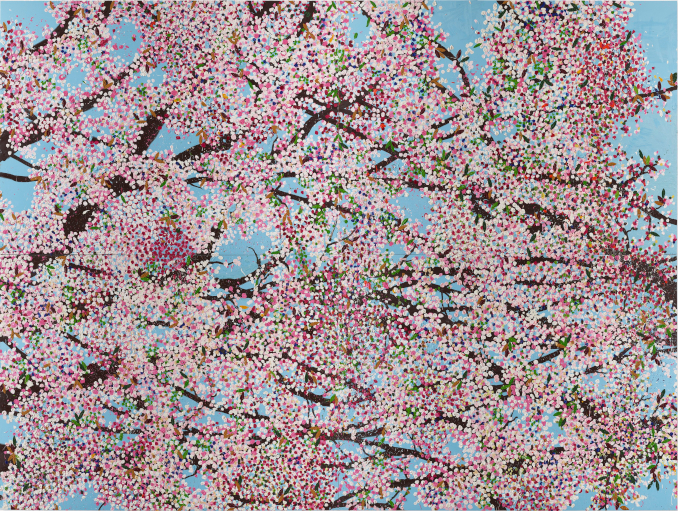
Damian Hirst. The Triumph of Death Blossom (2018). Private collection© Damien Hirst and Science Ltd. All rights reserved, DACS 2021. Photographed by Prudence Cuming Associates. Photo: Courtesy Fondation Cartier
By Nina Heyn – Your Culture Scout
September saw Parisians mostly spending their weekends out in the streets. Some of them (an estimated 17,000) were attending a demonstration; others participated in a celebration of “Days of European Heritage,” which was similar to a pan-European “Night of the Museum” event that normally takes place in May in most European cities. Scores of places with restricted access opened doors to the public for one weekend—from the very popular tour of the presidential palace (Macron was not there but the accoutrements of power were) to private libraries, schools, various organizations, and even factories.
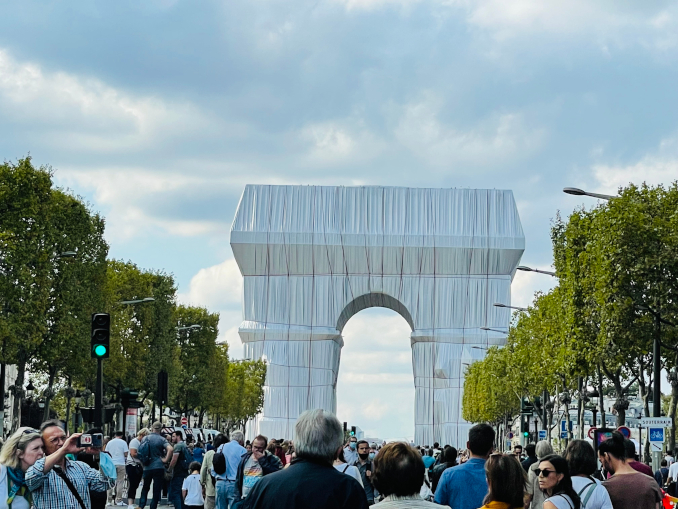
Christo. Wrapped L’Arc de Triomphe in Paris—a posthumous installation. Photo: Nina Heyn
Saturdays in Paris are often devoted to demonstrations (in France, demos are frequent but usually well-organized and planned in advance to help with traffic), and this time, it was a protest against the pass sanitaire—proof of vaccination needed to enter bars, restaurants, museums, and more. The protesters’ itinerary coincided with the heritage tour’s route, so eventually huge crowds ended up at the Champs-Elysées, partially closed to traffic. Whatever the reason to be out in the center of the city, Parisians were able to check out the temporary art installation of the century: the wrapping of L’Arc de Triomphe.
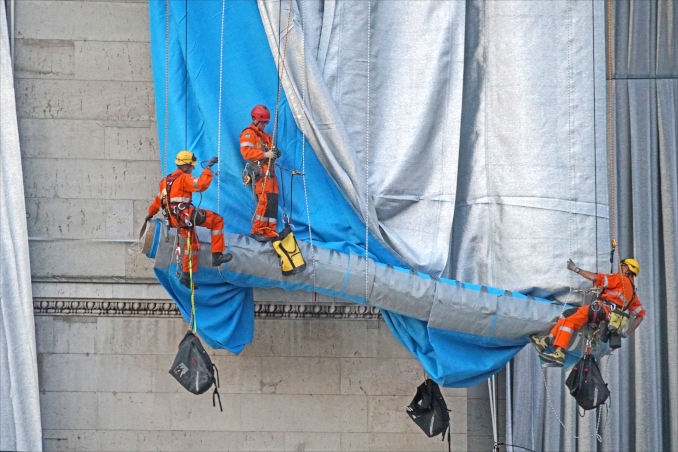
Wrapping of L’Arc de Triomphe. Photo: Jean-Pierre Dalbéra/Wikimedia Commons
Wrapping L’Arc de Triomphe in fabric was for 60 years a dream of artists Christo and his wife Jeanne-Claude. Christo passed away in 2020, so the realization of this installation is now a posthumous tribute. Christo and Jeanne-Claude made their name in the late 20th century through their unique art events that brought color and fabric to large outdoor spaces and landmarks. They installed orange banners throughout Central Park in New York, wrapped Berlin’s Brandenburg Gate in fabric to celebrate Germany’s reunification, and surrounded an entire island in a ribbon of pink sheeting. Their installations drew attention to the sites themselves but also transformed for a few weeks some known landmarks or elements of nature into new spaces. In keeping with their always ephemeral installations, the wrapping of l’Arc de Triomphe went up only for a couple of weeks (until October 3), with 270,000 square feet of silvery material transforming the Paris landmark into an event for visitors and locals alike. Christo’s final art adventure has now been fulfilled.
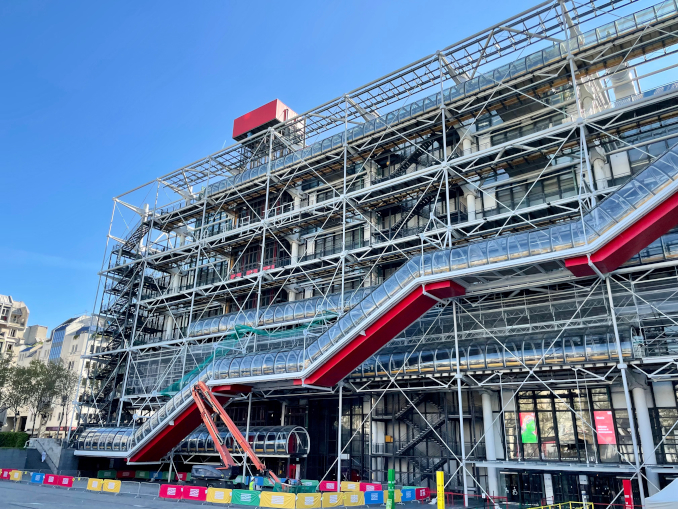
Centre Pompidou in Paris after recent renovations. Photo: Nina Heyn
For art lovers, Paris has several crowd-pleasing exhibitions to check out. The Centre Pompidou has brought out a meticulously researched retrospective of Georgia O’Keeffe. Amazingly, Paris has never had a major solo exhibition of this popular artist, an oversight that is more than rectified by the current show. The exhibition gathers artwork from all periods of O’Keeffe’s very long activity (she achieved the beautiful age of 99 years) and, therefore, goes beyond her most known gigantic flower canvases.
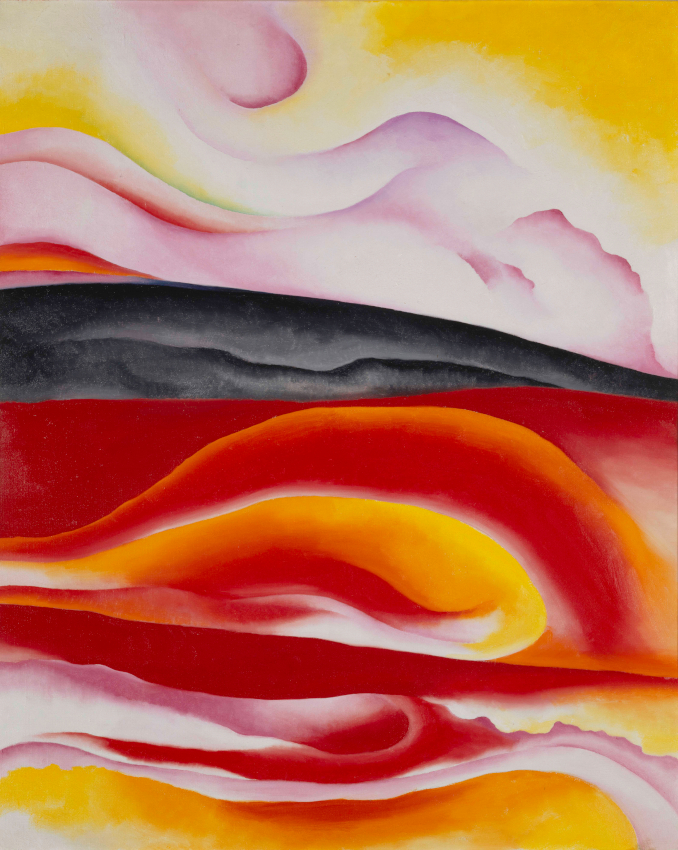
Georgia O’Keeffe. Red, Yellow and Black Streak (1924). Displayed at Centre Pompidou, National Museum of Modern Art, Paris. Gift of Georgia O’Keeffe Foundation, 1995. Photo © Centre Pompidou, MNAM- CCI/Philippe Migeat/Dist. RMN-GP© Centre Pompidou, MNAM-CCI.
The Centre Pompidou displays include O’Keeffe’s early Art Deco urban landscapes as well as her various series of bones and arid landscapes inspired by her life in New Mexico. The exhibition runs from September 8 to December 6, 2021, and I will write more about it in future Food for the Soul installments.
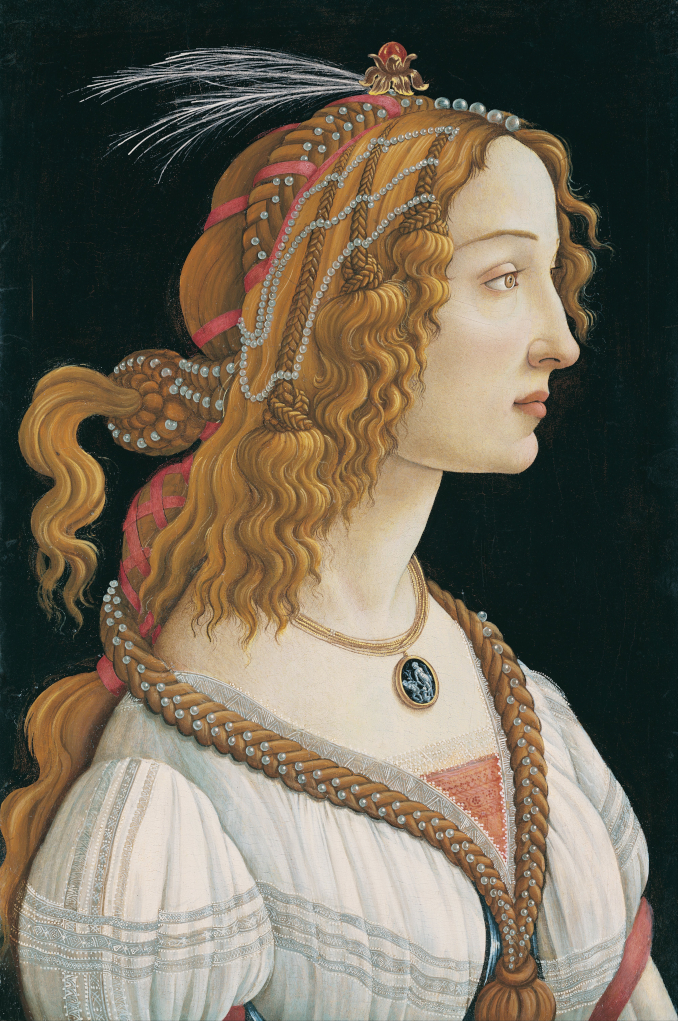
Sandro Botticelli. Idealized Portrait of a Woman (a.k.a. Simonetta Vespucci as a Nymph (1480s). Städel Museum, Frankfurt. Photo: Jose Luiz/Wikimedia Commons
The intimate Museum Jacquemart-André is known for mounting high-quality exhibitions. For the fall season, they put on an excellent overview of Sandro Botticelli’s art that highlights his prowess as a painter, a designer, and a manager of a large workshop. Examples of all his roles and types of artwork (Madonnas and other religious works, narrative paintings, book illustrations, tapestry cartoons) are displayed alongside examples from Botticelli’s predecessors (including his masterly tutor, Filippo Lippi) and contemporaries who inspired him. The exhibition draws from museums all over Europe, which allows visitors to see some less accessible but exquisite works. The famous La Bella Simonetta comes all the way from Frankfurt, while his whimsical and beautifully rendered illustrations for Dante’s Divine Comedy normally reside in the Vatican Library.
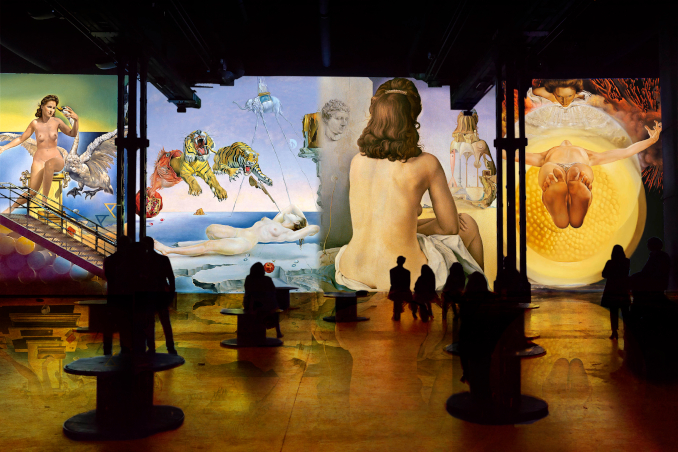
Salvador Dalí, Léda Atomique – detail (1947-1949), Fundació Gala-Salvador Dalí; Rêve causé par le vol d’une abeille autour d’une pomme-grenade, une seconde avant l’éveil – detail (1944), Museum Thyssen-Bornemisza, Madrid © 2020, Thyssen-Bornemisza/Scala, Florence; Ma femme, nue, regardant son propre corps devenir escalier, trois vertèbres d’une colonne, ciel et architecture – detail (1945), private collection© Bridgeman Images; Piéta, Ascension – detail (1958), private collection, Photo © Christie’s Images/Bridgeman Images. For all Salvador Dalí works: © Salvador Dalí, Fundació Gala-Salvador Dalí, ADAGP 2020 © Culturespaces/Nuit de Chine.
If someone wants great art served in a more relaxed way than in a reverential museum setting, then the digital experience of the Atelier des Lumières is always an unmissable visit. The Atelier’s new show, titled “Dalí – Mystery Without End,” draws from the large body of Dalí’s most famous works, ordinarily dispersed among many world museums but now reunited for a kaleidoscope of his unbridled imagination. The enormous wall screens project Dalí’s psychedelic colors and surrealist images, constantly transforming to the accompaniment of the equally psychedelic music of Pink Floyd’s greatest hits. As an encore, there is a show of Antoni Gaudí’s mosaics from his buildings in Barcelona. Any show at the Atelier des Lumières is an art experience (they have had shows dedicated to Gustav Klimt and van Gogh, for example), but this one is particularly gratifying. Moreover, the Culturespaces Foundation (the organization behind the show) runs an “Art in Immersion” program for disadvantaged children, making all their shows and workshops around them available to thousands of kids who “are made vulnerable by illness, or suffer from a handicap or social exclusion.” The Dalí show runs until January 2, 2022.

Salvador Dalí, Le spectre du Sex-Appeal (1934), Fundació Gala-Salvador Dalí; The Persistence of Memory (1931), MOMA, © 2019, Digital image, MOMA/Scala, Florence; Vestiges ataviques après la pluie (1934), Perls Gallery, New York, Photo: © Bridgeman Images. For all Salvador Dalí works: © Salvador Dalí, Fundació Gala-Salvador Dalí, ADAGP 2020© Culturespaces/Nuit de Chine.
One museum that is not worth bothering much with at the moment is the Picasso Museum. It used to offer the fabulous, educational experience of presenting all periods of Picasso’s long artistic life in one place. You could gain an understanding of how his artistic development and personal life intertwined for decades. The walls were bursting with masterpieces. Now, all the favorite Picasso works are stored. Instead, there are only thematic expositions displayed on a couple of floors for limited-time exhibitions. The latest one, hailed as a “landmark exhibition,” is called “Picasso-Rodin” and is a collaboration of the two museums—Picasso and Rodin. However, the end result is a bit underwhelming, and for me at least, it was hard to justify spending much time on this new post-pandemic concept of hardly any Picasso art inside a Picasso Museum. I was not the only confused and disappointed visitor seeking more Picasso art at the beautiful Hôtel Salé.

Damien Hirst in his studio, 2020 © Damien Hirst and Science Ltd. All rights reserved, DACS 2021. Photographed by Prudence Cuming Associates. Photo: Courtesy Fondation Cartier
Instead, both Parisians and visitors are flocking to a charming exhibition of Damien Hirst’s latest works—the show entitled “Cherry Blossoms.” Hirst, until now more known for his provocative installations (the famous “épater le bourgeois” conceptual art meditation on death included maggots in a glass box and a shark in formaldehyde) than for his paintings. The British artist seems to have made a 90-degree turn toward more traditional canvases though. His enormous hot-pink and aqua-blue splotches of paint are not only immensely cheerful and emotionally gratifying but also evoke so many other happy examples of ebullient nature in art—van Gogh’s Almond Blossom, David Hockney’s Yorkshire landscape series, Japanese ukyio-e prints, Georgia O’Keeffe’s flowers, or even Pissarro’s paintings of Pointoise. And if you like either Jackson Pollock or Georges Seurat, you would be very happy with these violent splotches of paint that reveal a complex visual thought behind them. Even when painting the tame pink flowers, Hirst does not lose the swagger of a radical conceptual artist. He is still the in-your-face, aggressive contemporary creator, cranking up the size and color of his enormous branches and flowering cascades, which tower above the viewer. However, the effect is decidedly happier than when he was avoiding painting in favor of his scandalizing installations and diamond-encrusted skulls. The public is responding with smiles on their faces—the enormous pink and blue canvases are a perfect art experience in view of the global depression. This is Hirst’s first museum exhibition in France, and it runs from July 6, 2021 to January 2, 2022.
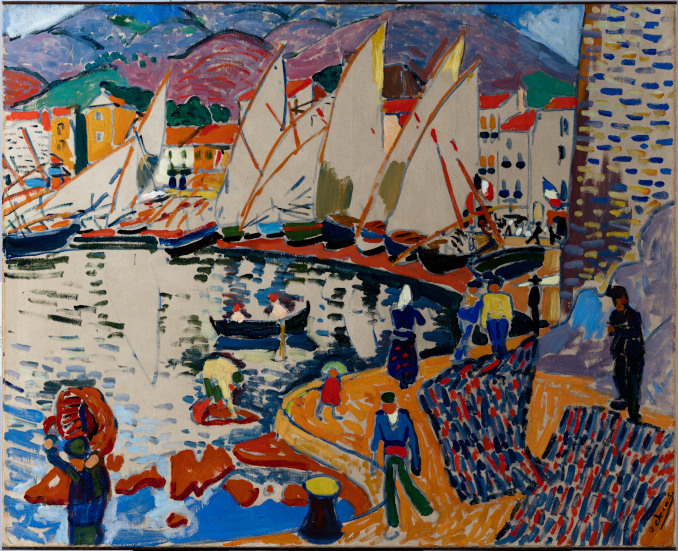
André Derain. Drying of Sails, Collioure (1905). Collection Morozov. Pushkin State Museum of Fine Arts, Moscow. Photo: © Adagp, Paris, 2021. Courtesy of Fondation Vuitton
The star of the fall/winter art season in Paris is a huge exhibition of the Morozov Collection mounted at the Fondation Vuitton. The exhibition titled “The Morozov Collection: Icons of Modern Art” pays tribute to two great Russian collectors, Michaïl and Ivan Morozov, who between 1890-1914 provided patronage to artists like Matisse and Derain and assembled one of the greatest collections of Impressionist and post-Impressionist works ever. The exhibition was rescheduled from 2020, and it has just opened to run until February 22, 2022. The scope and historical importance of this show are immense, and I will cover it in a future Food For the Soul installment.
